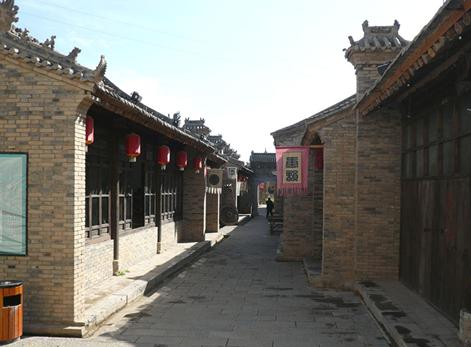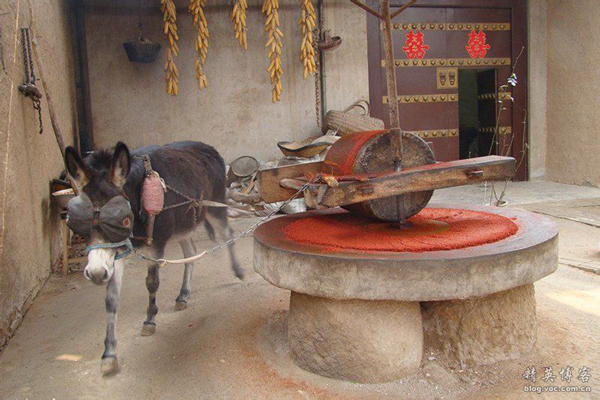 |
| Yuanjia Village’s well preserved old streets. |
 |
| Donkey-powered grindstones – the traditional way of grinding pepper. |
Nearby Attractions & Tips
Zhaoling Mausoleum
Zhaoling is located on Jiuzong Mountain. The sprawling mausoleum covers an area of 200 square kilometers and houses more than 180 tombs of Tang aristocrats and senior officials in addition to that of Emperor Li Shimin. It ranks first for the number of accompanying tombs among China’s imperial mausoleums and stands out among all Tang royal cemeteries.
Ruins of the Zhengguo Canal
on Mt. Zhangjia
In 246 BC, Qin Dynasty engineer Zheng Guo started an irrigation project on the eastern bank of Jinghe River, 25 kilometers west of Jingyang County. The 150-kilometer long canal was completed a decade later and named after the chief engineer. More irrigation facilities were built in the region during the subsequent regimes, making it “a museum of China’s ancient water conservancy.” It is now a historical site under state protection.
Adjacent is the impressive Jinghe River Canyon, dubbed Guanzhong’s No.1 Grand Canyon. Twenty-five kilometers northwest of Jingyang County and three kilometers west of Zhaoling Mausoleum, this natural wonder features rising peaks and jagged rocks. A beautiful river winds through the marvelous and secluded valley, forming a gorgeous landscape.
Transport
Yuanjia Village is easy to access from Xi’an, the provincial capital, and is suitable for a self-driving trip. Another option is to take the intercity bus. Take a shuttle bus to Yanxia Town from Xi’an Chengxi Station then transfer to a bus to Yuanjia Village. The village can also be reached via an express bus from Xianyang City.
Food
Guanzhong abounds in wheat so cooked wheaten foods are particularly tasty. It is said there are more than 50 types of cooked wheaten foods native to this region. You cannot miss these delicacies.
Fuzi (fermented barley)
This is a traditional snack in North China and tastes like the fermented glutinous rice that is popular in the south. However, fuzi is fermented from barley. It is hailed as a health food as it promotes digestion and reduces fluid retention in the body, among other benefits. Today, the skill of making fuzi has largely disappeared in cities and the dish is only found in rural areas.
Zhutou (chopstick) Noodles
This famous snack in Shaanxi Province gets its name from the girth of noodles, each about the same as the head of a chopstick. They taste wonderful tossed in hot rapeseed oil.
Baiji Pastry
This pastry is unique to Xianyang. The crust is thin and crisp while the filling is soft and delicious. It is best served with preserved meat and gravy. This affordable snack enjoys popularity beyond the province.
Qianxian Guokui
This is a type of pancake originating in Qianxian County. When baked evenly, it resembles a blooming chrysanthemum. It is thin around the edges and thick at the center and has several layers. The crisp pancake has a lingering aftertaste and is convenient to carry, making it the perfect on-the-go snack.
Paopao Yougao (puffy oil cake)
This is a notable snack from Sanyuan County of Xianyang. Its history can be traced back to the Tang Dynasty (618-907). Its stuffing comprises sugar, rose and walnut amongst others. The wrapping is made from flour mixed with boiled water and lard.
Xi’an Liangpi Cold Noodles
A snack not only famous in Xi’an but across the country, Liangpi’s unique taste appeals to all. The chewy strips of wheat or rice flour in variously seasoned sauce may taste sweet, tangy, tart or spicy. It is an ideal summer time snack
We recommend:
